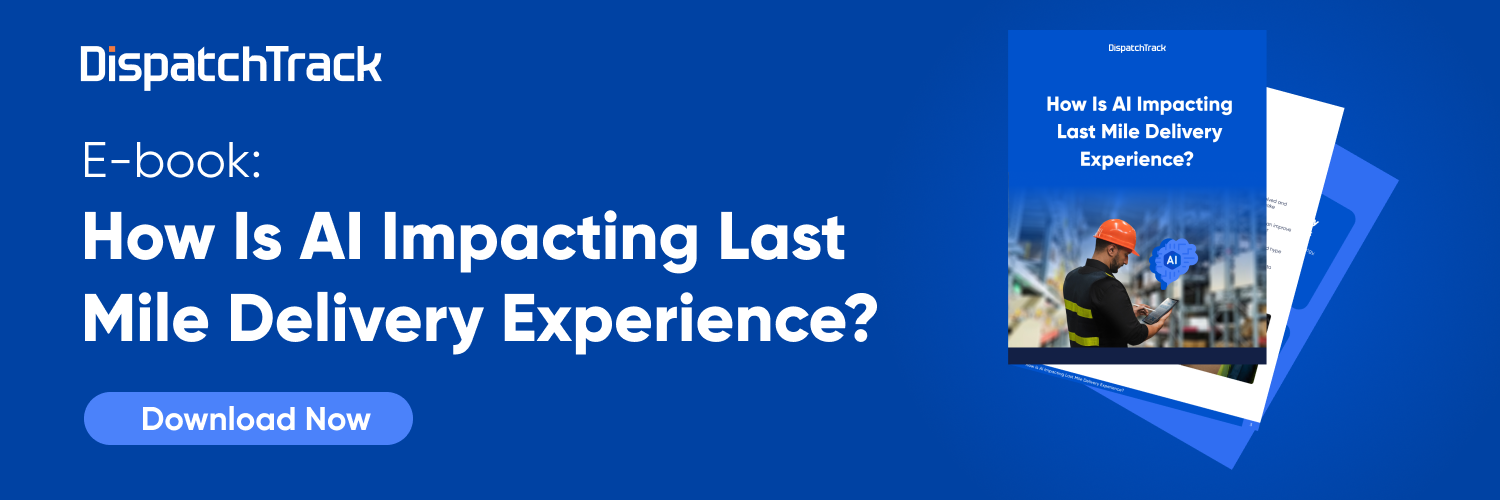To paraphrase a recent excerpt of a new report on AI in logistics that appeared recently in Talking Logistics, “the future of AI in logistics is already here — it’s just not evenly distributed.” 
Obviously, not everyone is deploying the newest and shiniest technology (and the newest and shiniest technology isn’t necessarily working consistently yet), but you don’t have to dig too far into the supply chain to find businesses who are already leveraging technologies that still seemed like science fiction even two years ago.
In the best case scenario, AI-powered logistics technology has the power to be a democratizing force, helping mid-sized companies compete with larger competitors who are less technologically savvy. It’s the same phenomenon that’s been happening with SaaS technology, and we’re seeing some businesses “outpacing [their] larger rivals” already using AI.
The flipside is that there is some inherent risk in navigating a changing technology landscape. AI agents are still wrong a lot of the time. Matching your expectations to reality and your deployments to your vision is easier said than done—more often than not it requires a strong technology partner with meaningful bona fides in both AI and logistics.
In this post, we’ll go over the specifics of the intersection of connected logistics and AI in the supply chain in 2025. We’ll cover what’s actually impacting logistics at this moment in time, what’s going to be immediately feasible within the next 6 months, and how businesses can deploy this technology within the context of connected logistics as a concept more broadly.
By the end of this article, you’ll be well equipped to approach AI deployments with an eye towards achieving practical results quickly and with a minimum of risk.
Index:
- What Is Connected Logistics, and Why Does It Matter?
- How Is AI Powering Connected Logistics in 2025?
- AI-Powered Connected Logistics with DispatchTrack
What Is Connected Logistics, and Why Does It Matter?
Before we can dive into the specifics of AI in connected logistics for 2025, we should define our terms. Connected logistics as a concept means different things to different people, but the upshot is that it means approaching logistics and fulfillment as a connected, cohesive whole.
Thus, instead of thinking of first, middle, and last mile logistics as discrete entities to be treated totally separately, treating each process as a connected part of the rest of the logistics chain.
In practical fact, this means a huge emphasis on visibility and connectivity across the supply chain. Any step you can take to ensure that every role has the data they need to do their jobs immediately available to them—and to make sure that as they’re doing their jobs they’re doing so in a way that provides visibility to other roles at the same time—gets you closer to connected logistics.
This kind of approach enables you to step back and look at your processes from end to end, with an eye towards ensuring standardization, compliance, and efficiency.
Some of the keys to making this possible are:
- Integrating your technology stack from top to bottom
- Capturing data in a standardized way across the board
- Accounting for all roles and functions in your technology deployments
- Prioritizing real, strategic visibility (no hunting for data in disparate spreadsheets)
- Digitizing and automating as much as possible
One day, AI will empower logistics professionals to handle integrations much more easily. For instance, your last mile technology might have an AI agent that’s able to communicate directly with your warehouse management to provide the data needed to route and schedule orders efficiently. This is still a ways off from being reality, however.
For right now, AI’s most immediate applications are in digitizing processes, automating workflows, and getting the absolute maximum out of the data you already have.
How Is AI Powering Connected Logistics in 2025?
Like we said above, the goal of AI-powered connected logistics is to reduce risk while saving time and money for your teams. The ideal of the autonomous supply chain is still far in the distance (though “far” by the standards of AI development may only mean a few years), but real ways of streamlining processes, simplifying tasks, and enhancing productivity with AI are out there.
In the realm of customer experience, large language models (LLMs) are currently making it possible to implement chat agents that respond instantly to customer questions and queries while escalating to a human support team member as needed. Here, the best practice is to start simple: implement an AI-powered chat agent that sits as a front line of defense in communications with customers.
Give the agent the ability to answer questions about delivery schedules and order details, with a clear protocol for contacting a human customer support rep for questions outside its remit.
It’s hard to overstate the impact such a simple deployment can have. At DispatchTrack, we’ve seen users of DT Agent decrease their inbound call volume by 80% and speed up customer inquiry resolution by 30%. By automating a process that’s trivial for a human but eats up a lot of time, you can focus more on providing a great customer experience where it counts.
Another area where AI can streamline connected logistics processes is in driver management. Specifically, the technology currently exists to enable businesses to embed AI-powered voice assistance into existing driver workflows. This might include location intelligence that lets the driver know what to expect at the upcoming stop in terms of parking or access—simplifying the thorny parts of the job so the driver can focus on providing a great customer experience.
The driver gets their job done more quickly and efficiently (which reduces delivery costs), and they can focus on doing the job right and documenting the process in a way that’s in compliance with your standards. This puts you in a position where you know that your drivers are both empowered and connected, and you’re enhancing their capabilities with greater connectivity.
Both of these show you connected logistics in action. In each case, stakeholders get the data that they need faster, and the entire logistics process—including customer experience and delivery execution—is smoother, more cost effective, and more visible.
The next areas to look out for these kinds of practical AI enhancements are dispatching and reporting:
- For dispatchers: AI has the power to leverage existing delivery data to proactively flag potentially problematic stops on individual routes. This can help you prevent delivery exceptions before they even happen.
- For executives and decision-makers: AI-powered data analysis capabilities (based on LLMs) can enable you to query data in a conversational way and receive an instant answer based on what’s in your database. This will speed up the time to make data-driven decisions considerably, meaning that logistics businesses will be able to get more out of their data than ever before.
Here, AI sits on either side of a virtuous cycle: it helps make logistics more connected, and it helps you make the most out of that connectivity by turning smarter data into more powerful processes and insights.
Like we said at the top, this isn’t pie-in-the-sky. These are simple, low-risk AI implementations that any organization can adopt right now to power connected logistics and reduce delivery costs.
AI-Powered Connected Logistics with DispatchTrack
At DispatchTrack, we’re working to provide AI-powered enhancements to last mile logistics that actually work. DispatchTrack’s AI-powered last mile delivery capabilities have helped customers decrease delivery costs, improve customer satisfaction, and significantly reduce manual effort and paperwork. The impact is smarter, more efficient logistics and a strong foundation for growth—all thanks to connected logistics powered by AI.
The last mile of the supply chain is where logistics planning collides with the reality of customer expectations. All of the optimization in the world can still fail to reduce costs when the customer isn’t available to receive the delivery or doesn’t even know when to expect the driver.
DispatchTrack’s portfolio of AI innovations has already shown itself to be extremely effective at improving customer experience in the last mile of the supply chain. As one user of DT Agent (Heather Simon, Director of Customer Care at 1915 South) noted, “DT Agent feels natural to our customers. It speaks their language, to-the-point, and always available.” She went on to add: “People don’t just expect fast answers—they expect them on their phones, in real time, without friction. That’s what DT Agent gives us.”
Another user, Cesar Bermudez (owner of CBC Moving) noted, “Most of the messages we were getting were simple things like, ‘What time is my delivery?’ or ‘Are you on your way? They weren’t hard questions, but they were slowing us down and we needed to respond to our valued customers.” By eliminating the manual effort associated with these questions, DT Agent has been immediately effective at improving the customer experience in the last mile of the supply chain.
Our industry-first Driver AI product takes this a step further by empowering drivers to more easily provide first-class delivery experiences to customers.
This has a huge impact in terms of both driver performance and customer experience—combined with DT Agent and our AI-powered routing, it enables supply chain organizations to reduce many of the costs associated with last mile delivery while providing a level of customer experience that would be nearly impossible (or prohibitively expensive) otherwise.
DispatchTrack’s innovative AI-powered routing system has a huge impact on the supply chain. We help our customers achieve:
- 98% or better ETA accuracy
- 50-70% faster route planning
DT Agent, our AI-powered customer experience agent, has shown major effects in terms of boosting customers’ supply chain efficiency:
- 70-80% of customer inquiries handled automatically
- 30% reduction in time to resolve customer messages
- 25 minute per stop reduction in average stop time
As costs in the supply chain become more volatile and labor shortages deepen, DispatchTrack’s AI-powered functionality enables the last mile of the supply chain to run more smoothly and effectively in spite of mounting challenges. Get in touch today to see whether our software can help you achieve connected logistics and greater delivery efficiency.
